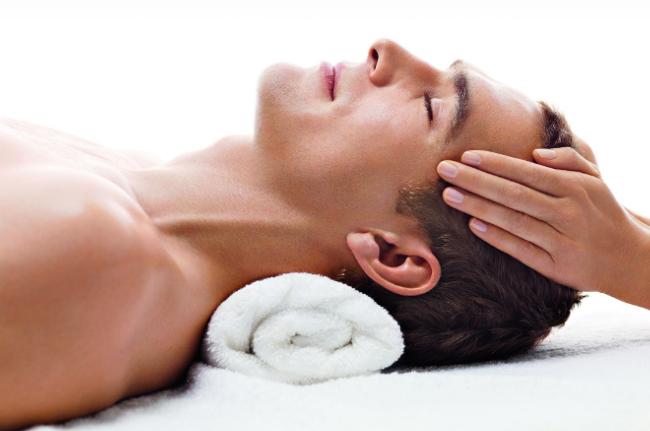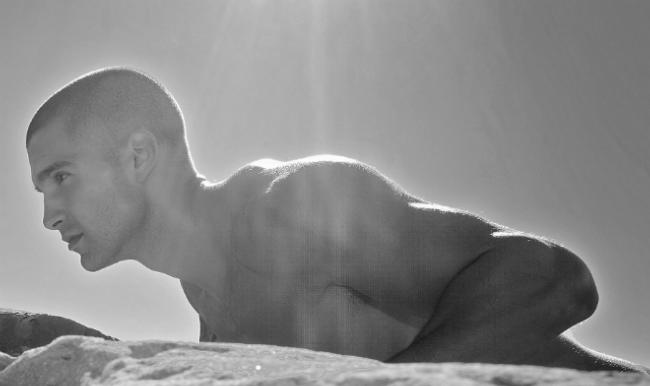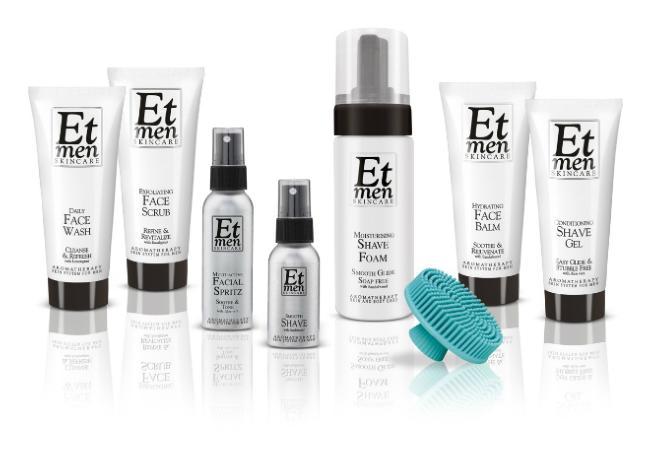Mad about the man
How the right strategy can help your spa drive male spend
WORDS SUZANNE BEARNE
It was once predominantly a woman’s world, but a shift in social behaviour means the global spa market is on track to become a man’s one too.
Whether it’s the David Beckham effect or a deep-rooted change in social attitudes, modern men care more about their appearance than ever before, paving the way for a host of services and products targeted at the newly groomed male.
The sector is experiencing real traction: the global value of the male grooming industry increased from $26.4bn (£17.6bn) in 2008 to $35.4 (£23.6bn) in 2013, according to figures from market analyst Euromonitor.
Men have slowly changed their attitudes and perceptions to grooming, says Clare Matthews, co-founder of male spa and skincare brand Vitaman. “Pressure from their partners to look good has swayed men to make more of an effort in their appearance and, in today’s competitive world, business expectations require [excellent] presentation and a high level of grooming.”
A room of one’s own
Despite this swelling market, many spas are failing to cater to men, meaning they’re loosing out on a potential new revenue stream. So what can spas do to capitalise on the male market?
Some smart operators have launched men-only destinations as a way to hone in on this burgeoning segment. These businesses include UK-based Gentlemen’s Tonic, which in the past few years has expanded into Hong Kong, India and Dubai and now counts world-class spas among its locations.
Other operators are being equally savvy by launching separate male-only areas within their properties, as a way to make men feel at ease in a place that some regard as out of their comfort zone.

Opening image: Aveda. Image above: Clarins
Take Aveda, which launched the Aveda Men grooming destination at its Aveda Lifestyle Salon & Spa in Covent Garden, London last August. Within the dedicated men-only space, clients can enjoy treatments such as the Express Refresh Facial and a manicure. The zone is Aveda’s first such space but if the pilot is successful, it will be rolled out across more of its locations.
“Men liked coming in anyway but we wanted to create an area where they have privacy and feel more secure,” says Georgina Hosny, spa co-ordinator at the Aveda Lifestyle Salon & Spa. “Men often do feel uncomfortable having a facial and putting a robe on [in front of women] so this works well for them.”
“It only needs to be one or two rooms but having a male zone within a spa is a great draw,” says Sothys UK brand manager Graham Clarke, who has noticed an uptick in the number of destination and hotel spas catering for men, particularly through the use of separate male areas.
Design notes
Not all businesses have the firepower to roll out standalone male spas or create separate grooming areas for men, but there are still a raft of ways to make the spa environment more male-friendly. Including making it more gender neutral, so it doesn’t purely feel like a female zone.
Spas can do this by ensuring décor is neutral and appeals to both sexes, like at The Shoreditch Spa in London, whose interiors feature iPads and leather armchairs, set against a backdrop of exposed bricks walls and turquoise hues.

Image: Sothys
Filling displays with products aimed at both men and women and showcasing a menu at the entrance that has men’s treatments alongside women’s are also good ways to capture the male market. Or you could take inspiration from Bliss Spa in Hong Kong, which has men’s sports magazines in the reception area.
“It’s very important that we remember to speak men’s language,” says Matt Taylor, a trainer and instructor for British skincare brand Eve Taylor. “If the business promotes itself as pink and pretty then this will vastly reduce the potential footfall of male clients.”
Spas should also provide gowns in men’s sizes and slippers big enough to fit their feet, and ensure their treatment tables are large enough to accommodate men. This will go some way towards making men feel of equal value to female clients.
Menu choices
Spas can also attract more male clients by offering a separate treatment menu for men. This is an approach that’s worked for the spa at country house hotel Rockliffe Hall in Country Durham in the UK, which has provided a separate treatment list for men since it opened five years ago.
As a result of a rise in demand for male treatments over the years, the spa has widened its menu to include grooming services such as manicures, pedicures and waxing.
The Adler Balance Hotel in Italy has offered a separate health and wellness programme for men for more than seven years, with a mix of treatments that include its South Tyrolean hay bath, a special hair loss treatment and facials and massages.
There are also a number of male packages, such as Man in Shape, available for three or five days and with eight treatments, including a manicure and pedicure, on offer and the Man Beauty Day, featuring a massage and a manicure, among other services. This is a spa that really ensures men feel as welcome as women.

Imagaeg: Vitaman
“It’s important to offer treatments that address men’s needs,” says Silvia Mittelberger, spa manager at Adler Balance Hotel. “The market for male treatments has grown a lot in the past years. On the one hand there’s demand for beauty treatments, but also for wellbeing and therapeutic treatments. Health seems to be much more important for men too now.”
When it comes to the number of men’s treatments to have on the menu, Jessica Hannah, trainer for marine skincare Phytomer in the UK, believes spas should provide a minimum of two facials and a body treatment. “I’m not sure if men are quite ready for a full on pamper day but pre-wedding day, de-stress and sport-relax packages could all be ways of introducing new offers to men,” she says.
Some experts warn spas not to overload men with too many treatment choices. “Simplicity and functionality is key when offering services to men. Bombarding men with multiple treatment options and pampering terminology will just turn them off,” says Taylor.
“Clear treatment descriptions with concise effects should be used: don’t focus on the emotional factors, like the aromas or how they will feel after. You should limit the treatments offered and, when it comes to facials, treatments lasting 45-60 minutes are completely adequate.”
Targeted treatments
Many brands agree that spas need to deliver treatments specifically for men, rather than treatments that are really designed for women, and simply tweaked for men.
Annette Close, general manager for Australian Bodycare, which distributes Phytomer in the UK, says: “If we reversed it, would we as women be happy having a facial that was designed for men and adapted for women?”
She recommends that spas offer treatments that deal with shaving issues, hydration and skin smoothing, as well covering more “unsociable conditions”, such as acne on the face, back or chest and dry and flaky skin.
With the rise in grooming bars and with men even having treatments such as manicures, pedicures, tanning and eyebrow threading [to a greater extent], opening up treatment menus to include these [types of services] will encourage more men into salons and spas,” says Marie McKeever, head of treatment development for Clarins UK.

Image: Eve Taylor
Anti-ageing treatments, firmly on most women’s tick box when they visit a spa, is quickly becoming an important area of focus for men too – so offering services that address this issue will drive spend.
“Anti-ageing for men is seeing some of the biggest growth rates within the skincare industry, so providing advanced treatments that focus on the signs of ageing would be a very prudent move,” advises Taylor.
There’s also room for a wide range of additional treatments for men. “Even less masculine treatments traditionally reserved for women, like [intimate waxing] are now being booked by men.
This has resulted in the creation of treatments such as the ‘boyzilian’ [a bikini wax for men],” says Spafinder Wellness UK’s managing director John Bevan, who points to Bliss Spa, which introduced a waxing menu for men in 2011.
Maximising marketing
One way spas can capture more male clients is by leveraging their existing female database. This can be achieved through means such as offering female clients product samples to give to their partners and developing more couples’ treatments.
Vitaman’s Matthews suggests tapping into local businesses to capture a new market. “Host after-hours events in the spa for men working at nearby offices,” she advises.
Hannah says spas could organise a male treatments promotion evening with an interesting guest speaker or wine tasting to start building their male clientele.
Bevan adds that, in order not to alienate men, spas should make it clear if they have certain times or days that they market to groups of women, “so single men can choose to avoid being confronted with large numbers of women in the spa”.

Image : Marks & Spencer
Spas might also win over men by overhauling their existing marketing and targeting some of its literature towards men, using straightforward and simple language. In other words, cut out the jargon and flowery prose.
“Men like to be spoken to in simple terms”, says Deborah Gayle, general manager of men’s grooming salon The Refinery. “They just want to know what it does, how long it takes for results to be seen and what is actually going to happen during the process.”
Matthews echoes this: “Men just need to know the how, when and why; they want the facts, not the fluff.”
Profit points
Spas can reap as many financial rewards from making men feel more welcome as they would from targeting any other demographic.
“Men are just as profitable as clients as women are; it’s the person attending to their needs that determines the profitability,” says Matthews. “Men buy on facts – they want to know how, when and why they should use a product or have a treatment.
They are education-focussed, compared to women who are more emotional when purchasing products or treatments. Men are the easiest to upsell to, and treatment packages should always be offered.”
Aveda’s Hosny says men tend to make more loyal customers. “The turnover retention with men is much higher than with women. I find men easier to sell to, once they’re with you, they stay with you as a client.”
Based on current trends, the grooming market is only going to increase, says Bevan. “Spas have a real opportunity to grow the number of men they attract,” he adds. Making a new, savvy approach to men’s grooming something worth sprucing up on.

